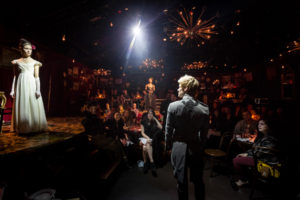In today’s Wall Street Journal “Sightings” column I write about the immersive-art trend. Here’s an excerpt.
* * *
Not counting “Hamilton,” Broadway’s hottest musical is “Natasha, Pierre and the Great Comet of 1812,” an “immersive” show for which the Imperial Theatre has been remodeled in order to put the cast in the laps of the audience. Runways in the orchestra, onstage cabaret seating inches away from the performers, stairways leading directly from the stage to the balcony: Everybody’s everywhere.
 “The Great Comet” is a prime example of “immersive theater,” which blurs the borderline separating artists from spectators. It’s the number-one buzzword in theater—but it’s not an exclusively theatrical phenomenon. Broadly similar ideas are popping up throughout the wider world of art, so much so that merely to play a symphony, hang a painting or dance a ballet is becoming almost passé. In London, choreographer Will Tuckett staged a “Nutcracker” in which the audience served as guests at the first-act Christmas party. Major orchestras, including the New York Philharmonic, are booking “Disney ‘Fantasia’ Live in Concert,” in which the animated film is shown on a giant movie screen while Beethoven, Stravinsky and Tchaikovsky are played live….
“The Great Comet” is a prime example of “immersive theater,” which blurs the borderline separating artists from spectators. It’s the number-one buzzword in theater—but it’s not an exclusively theatrical phenomenon. Broadly similar ideas are popping up throughout the wider world of art, so much so that merely to play a symphony, hang a painting or dance a ballet is becoming almost passé. In London, choreographer Will Tuckett staged a “Nutcracker” in which the audience served as guests at the first-act Christmas party. Major orchestras, including the New York Philharmonic, are booking “Disney ‘Fantasia’ Live in Concert,” in which the animated film is shown on a giant movie screen while Beethoven, Stravinsky and Tchaikovsky are played live….
The target audience for most of these presentations is the under-40 generation, fewer of whose multitasking members go to concerts, plays or museums with any regularity. The idea of buying a ticket to “La Bohème” or “Romeo and Juliet,” then showing up next Tuesday at eight o’clock sharp and sitting down to watch the performance, is increasingly alien to them. “Art” is something they download and experience at a time and place of their choosing, more often than not alone rather than in the company of others.
How to get such folk off their couches? One approach is to present art in a way that, like “Disney ‘Fantasia’ Live in Concert,” appeals to more than one of the senses. Another is to offer them a participatory experience—a “show” that’s active rather than passive. Such is the new conventional wisdom, and there’s something to it…
I have mixed feelings about the participatory-art trend, not because I’m rigidly opposed to it but because it too often seems to exist in tension with the old-fashioned way of experiencing art, which is by paying full attention to it. How well can you see Picasso’s “Les Demoiselles d’Avignon” when you’re simultaneously reading about it on your smartphone or hearing it described by a voice in your ear?….
* * *
Read the whole thing here.

 •
• 